The persecution, hardships, suffering and discouragement that accompanied the Pilgrims before they even began their journey has caused many to wonder how their conviction to continue remained so constant. Consider first, not all of the congregation could depart in 1620, so a remnant had to volunteer. Second, the change in their contract was a huge setback of money and morale. Third, selling the Speedwell added to their financial loss and created another sad parting. Finally, the loss of precious time increased their chances of a stormy crossing and insured they would land in winter.
By the time the Mayflower and the leaky Speedwell returned to Plymouth Harbor in England, probably around August 26 (old style calendar), those traveling to the new world had already been at sea for six weeks! They would spend another two weeks discerning what to do with their leaky ship and also who might have to return and not attempt the voyage.
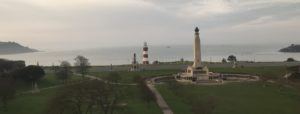 Plymouth’s history dates back to King Alfred’s Domes-day Code of Law Book which articulated the Common Law. It was referred to in that book in 1086 as Sudtone or “South Farm.” It became known as Sutton Harbour. In the 15th century as ships began to use the river Plym’s tidal mouth the town took the name of the river Plym’s mouth or Plymouth. The Hoe (large open space), makes it one of the most picturesque harbors in the world.
Plymouth’s history dates back to King Alfred’s Domes-day Code of Law Book which articulated the Common Law. It was referred to in that book in 1086 as Sudtone or “South Farm.” It became known as Sutton Harbour. In the 15th century as ships began to use the river Plym’s tidal mouth the town took the name of the river Plym’s mouth or Plymouth. The Hoe (large open space), makes it one of the most picturesque harbors in the world.
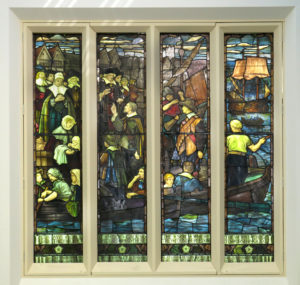 An amazing providence was the connection the Pilgrim exiles made with a reformed group of believers already meeting in the town.
An amazing providence was the connection the Pilgrim exiles made with a reformed group of believers already meeting in the town. 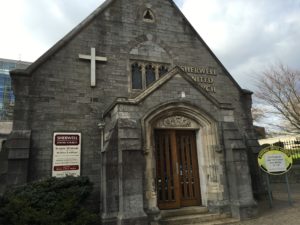 When visiting Plymouth in 2016 we saw an amazing stained glass window inside the Sherwell United Church’s chapel building. It depicts the Plymouth congregation praying for our Pilgrim exiles before they departed. The famous steeple of St. Andrews can be seen in the background (and still stands). The Pilgrims would providentially settle in what had already been named “New Plimouth” by John Smith in 1614. At the base of the stained glass window the inscription reads “Happy is that people whose God is Lord. Aye, call it holy ground, the soil where they first trod. They left unstained what there they found, freedom to worship God.”
When visiting Plymouth in 2016 we saw an amazing stained glass window inside the Sherwell United Church’s chapel building. It depicts the Plymouth congregation praying for our Pilgrim exiles before they departed. The famous steeple of St. Andrews can be seen in the background (and still stands). The Pilgrims would providentially settle in what had already been named “New Plimouth” by John Smith in 1614. At the base of the stained glass window the inscription reads “Happy is that people whose God is Lord. Aye, call it holy ground, the soil where they first trod. They left unstained what there they found, freedom to worship God.”
 The Pilgrims would leave from the Barbican, “a maze of narrow streets and alley ways, adjacent to Sutton Harbour, the original seaport…” The “Mayflower steps” are made famous for the departure of the Pilgrims from Plymouth on Wednesday, September the 6th, 1620.
The Pilgrims would leave from the Barbican, “a maze of narrow streets and alley ways, adjacent to Sutton Harbour, the original seaport…” The “Mayflower steps” are made famous for the departure of the Pilgrims from Plymouth on Wednesday, September the 6th, 1620. 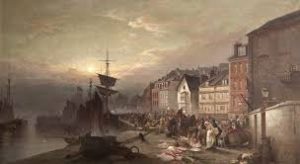 Here Richard Holland and I, in Pilgrim attire, pose on the modern steps of the Barbican in 2016. The famous painting of the Barbican Quay in Plymouth by William Gibbons (1841-1890), depicts the Pilgrims about to depart on their journey of faith to America. Some of the same buildings on the Barbican in 1620 can be seen today!
Here Richard Holland and I, in Pilgrim attire, pose on the modern steps of the Barbican in 2016. The famous painting of the Barbican Quay in Plymouth by William Gibbons (1841-1890), depicts the Pilgrims about to depart on their journey of faith to America. Some of the same buildings on the Barbican in 1620 can be seen today!
In some of those dwellings depicted on the Barbican in the above 19th century painting, the pressure and discouragement had accumulated and taken its toll. Such pressure reveal an individual’s character and God uses this to bring impurities to the surface. Bradford writes about the time in Plymouth after it was decided to sell the Speedwell and for some to return and not make the voyage.
 Bradford writes: “So after they had took out such provision as the other ship could well stow, and concluded both what number and what persons to send back, they made another sad parting; the one ship going back for London and the other was to proceed on her voyage. Those that went back were for the most part such as were willing so to do, either out of some discontent or fear they conceived of the ill success of the voyage, seeing so many crosses befall, and the year time so far spent. But others, in regard of their own weakness and charge of many young children were thought least useful and most unfit to bear the brunt of this hard adventure, unto which work of God, and judgment of their brethren, they were contented to submit.”
Bradford writes: “So after they had took out such provision as the other ship could well stow, and concluded both what number and what persons to send back, they made another sad parting; the one ship going back for London and the other was to proceed on her voyage. Those that went back were for the most part such as were willing so to do, either out of some discontent or fear they conceived of the ill success of the voyage, seeing so many crosses befall, and the year time so far spent. But others, in regard of their own weakness and charge of many young children were thought least useful and most unfit to bear the brunt of this hard adventure, unto which work of God, and judgment of their brethren, they were contented to submit.”
Among those who did not continue were the crew of the Speedwell. The crew may have proven difficult to deal with for the entire year agreed upon). Robert Cushman (and his family) returned, and he was the leader who agreed to the change in their contract, producing friction among them. 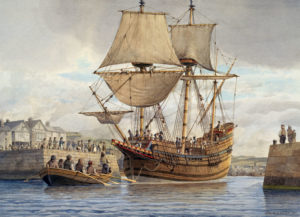 Christopher Martin (their Governor on the Speedwell) was dictatorial, offending everyone. Thomas Blossom also returned. He, along with his wife Anne, had lost two children by 1620, and another by 1625, persevered and came in 1629 on another ship called Mayflower! Could it be that God removed some and refined others like Blossom who would convince more to eventually come? A total of 20 returned, and 11 would cram on the crowded Mayflower. Winslow relates: “Wednesday, the sixth of September. The wind coming east-north-east, a fine small gale, we loosed from Plymouth, having been kindly entertained and courteously used by divers friends there dwelling…”
Christopher Martin (their Governor on the Speedwell) was dictatorial, offending everyone. Thomas Blossom also returned. He, along with his wife Anne, had lost two children by 1620, and another by 1625, persevered and came in 1629 on another ship called Mayflower! Could it be that God removed some and refined others like Blossom who would convince more to eventually come? A total of 20 returned, and 11 would cram on the crowded Mayflower. Winslow relates: “Wednesday, the sixth of September. The wind coming east-north-east, a fine small gale, we loosed from Plymouth, having been kindly entertained and courteously used by divers friends there dwelling…”
Bradford concluded: “And thus, like Gideon’s army, this small number was divided, as if the Lord by this work of His providence, thought these few too many for the great work He had to do.”
May we react with patience and perseverance when things do not go our way – hardship, financial loss, or other separation from people. God is in control and maybe He has a great work for us to do as well!







